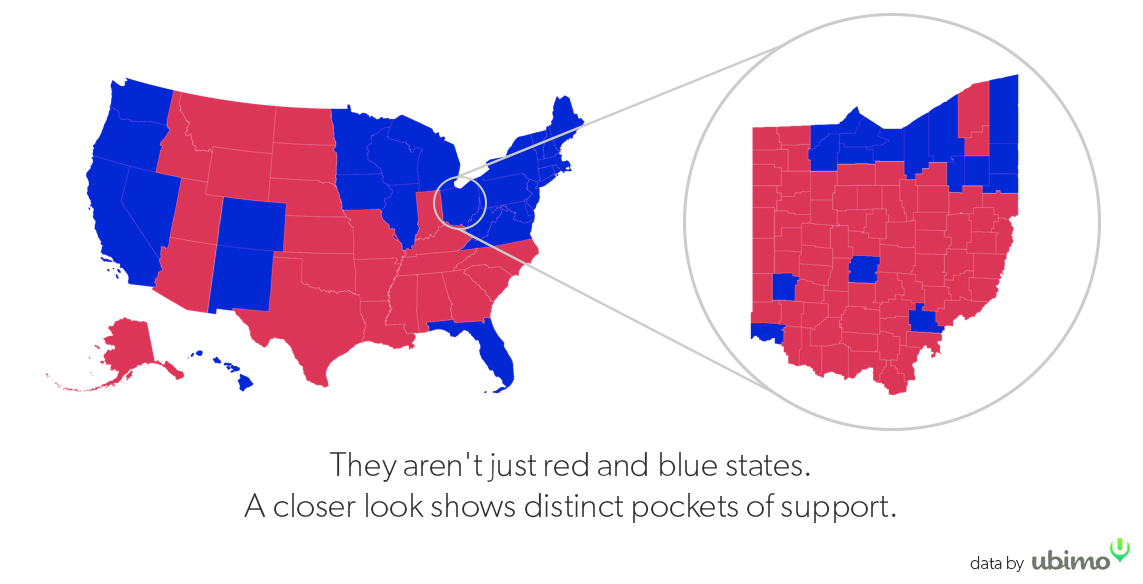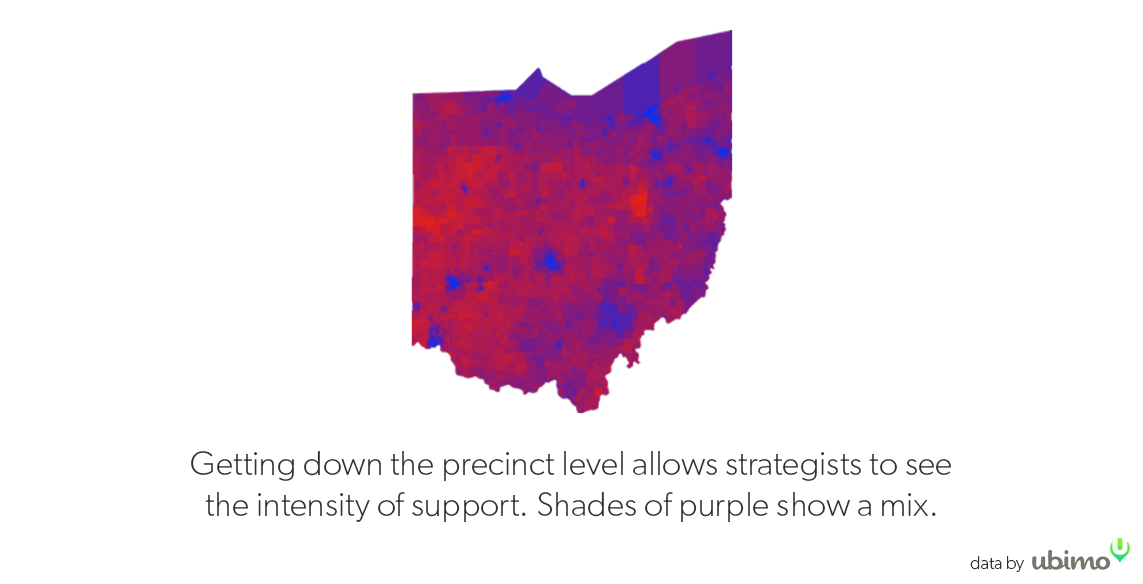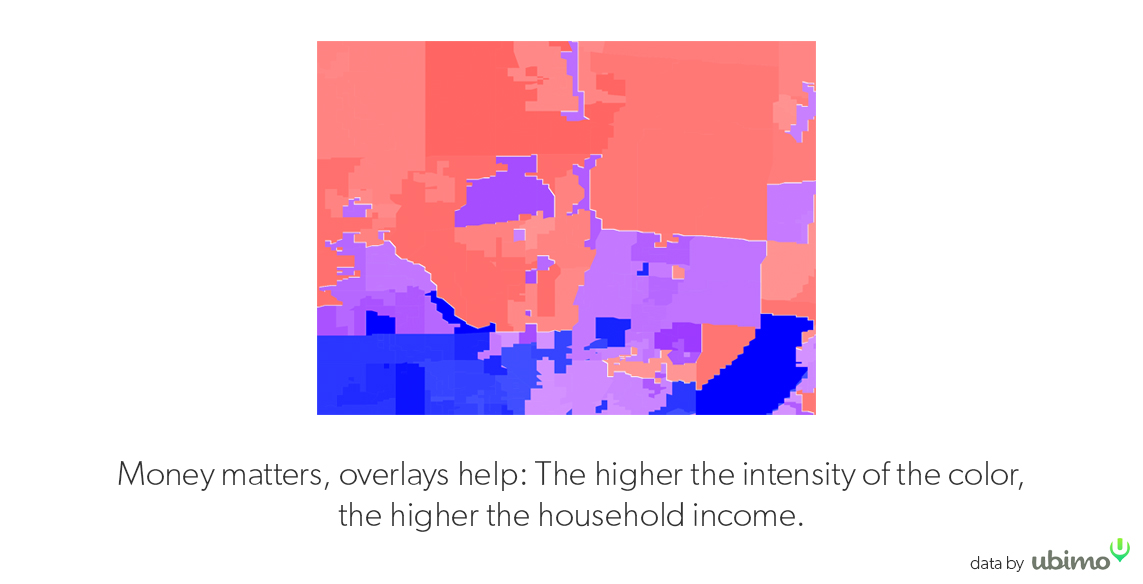Navigating Iowa: How political strategists find swing voters down to the city block

Mark Langgin lives in Iowa, and right now, his browsers are flooded with ads supporting Republican candidate Jeb Bush. Right To Rise, Bush’s political action committee (PAC) is making sure he’s everywhere online in the lead-up to the first-in-the-nation caucus.
Just one problem. “I’m a Democratic consultant; I’m not his target audience,” said Langgin, a partner at political media agency GPS Impact. “So sometimes I question why I’m seeing so many Jeb Bush ads. It seems like inefficient targeting.”
Courting the middle
In a battleground state like Iowa, you really have to focus on your “persuasion audience.” As Langgin puts it, “You’re going to have 15 percent of your likely voters going in one direction, hardcore supporters, and 15 percent in another. They’ve [already] sort of retreated to their corners.” The truly savvy strategists focus on the shades in the middle, though most of those, while non-committal, are already leaning.
“They need a nudge or a reminder to stay where they’re at,” said Langgin, with emphasis on getting out the vote. Often, only 5 to 15 percent of the electorate are actually the hallowed “swing” component that will end up deciding the election in states like Ohio, Pennsylvania and Florida. So how do you find them online?
Well, in the pre-Obama days, most candidates defaulted to a broad approach, inferring affiliation through different types of early behavioral targeting: keywords, page context, etc. “Adwords was very dominant,” said Langgin. “Early stage digital was really focused on direct response: email acquisition, fundraising, volunteer development.” The rise of targeting tools and more content-heavy formats began to open the door to awareness and issue-specific appeals, a strength only enhanced by mobile.
Managing mobile: When granularity is too much
“The reach and frequency of online video has scaled along with mobile,” said Langgin about politician’s favorite means for reaching the common man. “Campaigns are becoming more screen-agnostic; their messages are coming on a mobile phone, a desktop, a tablet or a TV screen.” This cycle, Langgin has seen a decided shift from desktop to mobile-centric digital campaigns.
Through geo-targeting, mobile is also bringing specific location into the digital planning and strategy to a level only comparable to canvassing and direct mail. But with access to individual information through voter files, political marketers can struggle with the temptation to go too granular, which doesn’t come cheap and only gives access to about 20 to 30 percent of voters. Attempts to extend these precisely targeted campaigns by adding multiple third-party data sets ups the complexity — and the cost.
“There are huge limitations to working with that first-person, very granular individual data in reach, so practitioners like myself are often looking for tools that allow them to have a layered approach to how we’re treating targeting,” said Langgin.
“Digital and political campaigns fit into some middle ground between door knocking, paid phones and direct mail which are very targetable at the individual household level versus radio and television which is far more broadcast.” To keep CPMs down, political marketers can focus on small areas close to the precinct-level where pockets of likely supporters are concentrated.
Know your precinct: Getting beyond affiliation
Of course, whether a constituent is a Democrat or a Republican isn’t the only thing that goes into targeting — or shapes the messaging it informs. “When it comes to working in politics, it’s a lot about gender, ethnicity, economic indicators and those sort of things.” And being able to see how these factors play out at the precinct-level can add new dimensions and more nuance to campaign messaging.
But going too issue-specific on mobile does have its dangers. “Who wants to be smacked in the face with an anti-abortion ad when you open up Facebook in the morning?” asked Langgin. And at home, where families often share devices, inadvertently exposing someone’s children to divisive issues can do more harm than good. “Political messaging is not always the softest, and so targeting at the geographic or even the device level can kind of get squishy when you’re dealing with some of those tough social issues.”
But when it works, it pays dividends. The Clinton campaign has proven particularly adept at this game of digital Marco Polo. “They’ve built pretty well-integrated drip campaigns: comprehensive remarketing campaigns where they’re working to move potential caucus goers from being generally interested down a funnel to being someone who spends 3 or 4 hours on caucus night.”
Getting the right messaging to the right people is crucial here. In a way, the fate of the country is at stake, and marketers have to do it all in one take. “It’s not like a brand marketing situation where you constantly get to go back and try to win consumers. If you don’t win in November, you’re done.”
Learn more about how Ubimo is working to drive voters via micro-targeting.
More from Digiday

What TikTok’s e-commerce launch could mean for marketers and content creators
TikTok has officially launched its new e-commerce platform, TikTok Shop, earlier this month on August 1. Using the new e-commerce platform, brands and creators can sell products directly on the platform, potentially creating new revenue streams, and tap into the short-form video platform’s growing popularity.

‘The influencer industry can be really vile’: Confessions of an influencer marketer on the industry’s unfair hiring practices
While the influencer industry might sound exciting and like it’s full of opportunities, one marketer can vouch for the horrific scenarios that still take place behind the scenes.

Digiday+ Research: Marketers said revenue grew in the last year, with more growth expected ahead
After a tumultuous 12 months, marketers are getting a clear picture of how they really did during a time of true uncertainty. And, as it turns out, it wasn’t all that bad.
Ad position: web_bfu


